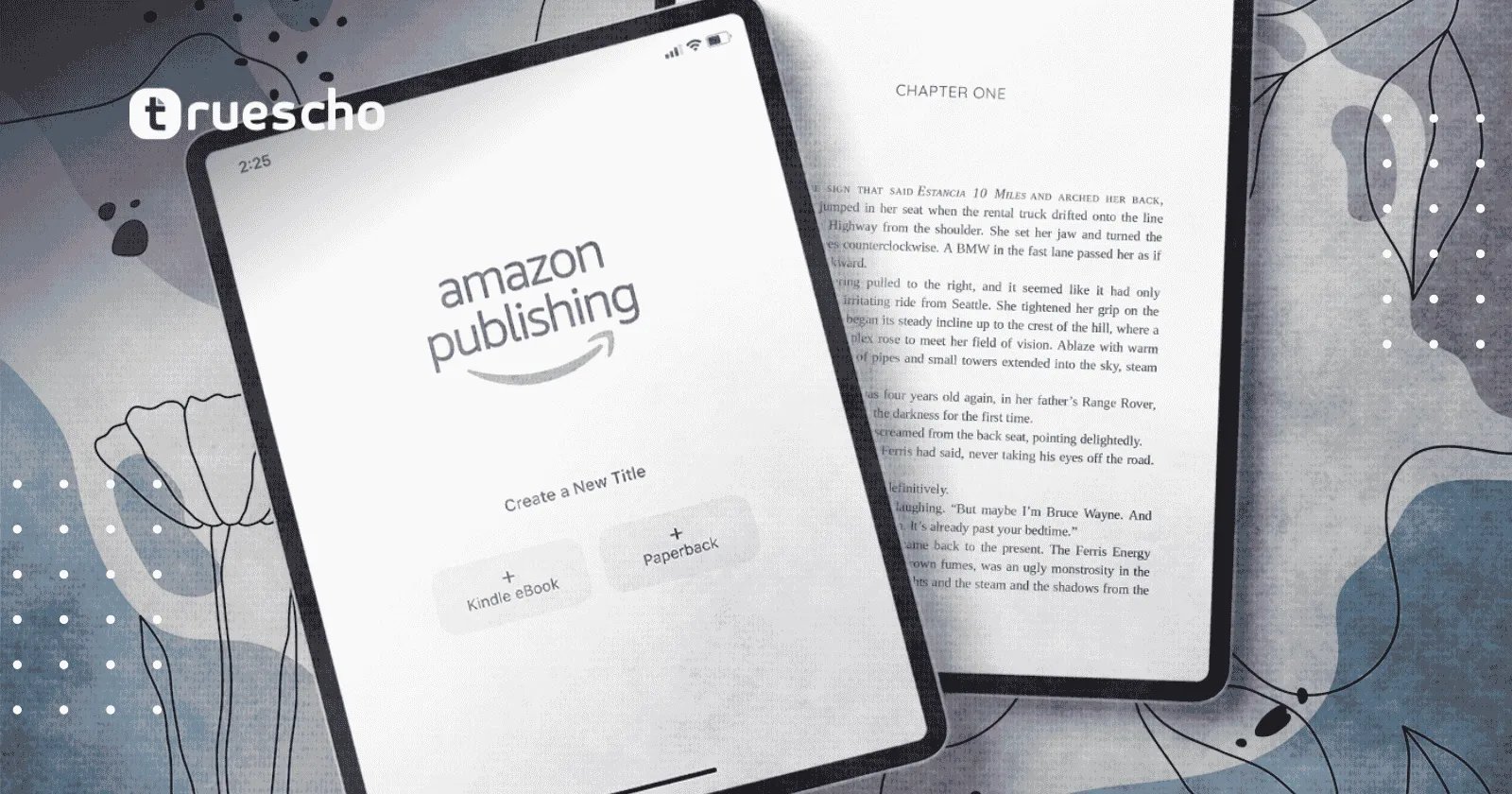نجاح أمازون KDP مع نشر الكتب منخفضة المحتوى
تعلم كيف حول رائد أعمال شغفه إلى عمل مربح على أمازون KDP. يتعمق هذا المقال في رحلة إنشاء كتب ذات محتوى منخفض ومتوسط، ويقدم نصائح واستراتيجيات مجربة، بالإضافة إلى دور الأدوات التكنولوجية الحديثة، بما في ذلك الذكاء الاصطناعي، في بناء مشروع نشر مستدام.
جدول المحتويات
- 1 الرحلة: من الاكتشاف إلى الالتزام
- 2 نظرة ثاقبة على نشر الكتب ذات المحتوى المنخفض والمتوسط
- 3 الدروس الأساسية المستفادة في رحلة أمازون KDP
- 4 استراتيجيات إنشاء كتب عالية الجودة على أمازون KDP
- 5 دمج الذكاء الاصطناعي في عملك على أمازون KDP
- 6 توصيات للمبتدئين في أمازون KDP
- 7 بناء علامة تجارية مستدامة للنشر
- 8 الخلاصة
الرحلة: من الاكتشاف إلى الالتزام
تبدأ القصة بعد فترة وجيزة من الانتهاء من الجامعة – عندما كان مؤسس قصة النجاح هذه يبحث عن نماذج أعمال عبر الإنترنت لتحقيق الاستقلال المالي. قادته دراسته إلى أمازون KDP حيث بحث عن نموذج عمل قابل للتطوير ومنخفض المخاطر. في البداية، اشترى دورة تدريبية بقيمة 10 دولارات أمريكية حول أساسيات نشر KDP، والتي وضعت الأساس لإطلاق كتابه الأول.
على الرغم من أنه حقق نجاحات صغيرة على الفور، إلا أنه كان يعلم أنه لتحقيق دخل مستدام، كان من الضروري اتباع نهج منضبط ومركّز. حتى أثناء التجريب بأشكال أخرى من ريادة الأعمال الرقمية، مثل التجارة الإلكترونية ودروبشيبينغ، أصبح من الواضح أن أمازون KDP يقدم طريقًا أكثر أمانًا وعضوية نحو النجاح.
تؤكد هذه الرحلة أن النجاح الحقيقي مع أمازون KDP لا يعتمد فقط على الإيرادات الفورية، ولكن أيضًا على الاتساق والالتزام ببناء منتجات عالية الجودة بمرور الوقت.
اقرأ أيضا: النجاح في نشر الكتب على أمازون KDP
نظرة ثاقبة على نشر الكتب ذات المحتوى المنخفض والمتوسط
أحد الجوانب الرئيسية لنموذج أعمال أمازون KDP هو نشر الكتب ذات المحتوى المنخفض. قد تتضمن هذه الكتب كتب تلوين ومجلات ومخططين، حيث يكون التركيز الرئيسي على التخطيط والتصميم بدلاً من المحتوى المكتوب المكثف. بمرور الوقت، توسع رائد الأعمال في ما يُعرف باسم نشر الكتب ذات المحتوى المتوسط – كتب تعرض مواد تعليمية منظمة مقترنة برسومات ورسوم توضيحية أصلية.
كان هذا التطور في استراتيجية المحتوى مدفوعًا برغبته في بناء طول عمر للعلامة التجارية. من خلال إنشاء كتب فريدة من نوعها لا تعتمد فقط على حركة المرور العضوية من أمازون ولكن يمكن أيضًا تسويقها بالإعلانات، كان قادرًا على تقليل المخاطر وإنشاء خندق تنافسي داخل مكانه.
تشمل بعض النقاط الأساسية حول سبب فعالية النشر ذي المحتوى المنخفض والمتوسط:
- استثمار أولي منخفض: يمكنك البدء في نشر الكتب بتكلفة أولية قليلة أو معدومة.
- قابلية التوسع: بمجرد أن تفهم العملية، يمكنك تكرار النموذج لتوسيع محفظتك من العلامات التجارية.
- حركة المرور العضوية: يعني النشر على أمازون الاستفادة من قاعدة عملائها الهائلة دون الدفع مقابل الإعلان.
- التميز في الجودة: يساعدك إنشاء منتجات ذات قيمة أعلى بتصميم ومحتوى مميز على التميز في سوق مزدحم.
الدروس الأساسية المستفادة في رحلة أمازون KDP
تتميز رحلة تحقيق النجاح على أمازون KDP بالعديد من الدروس الهامة:
- ابدأ صغيرًا، وتعلم بسرعة: ابدأ بنشر بضعة كتب لفهم آليات النظام الأساسي والسوق. كما أوضح أحد الخبراء، فإن نشر كتابه الأول – حتى لو حقق دخلًا متواضعًا فقط – وفر الثقة لتوسيع نطاق العمل.
- ركز على الجودة: سواء اخترت إنشاء محتوى الكتاب بنفسك أو الاستعانة بمصادر خارجية لمهام مثل التصميم الجرافيكي، فإن ضمان الجودة العالية أمر ضروري للحفاظ على المبيعات العضوية والسمعة طويلة الأجل لعلامتك التجارية.
- استفد من المجتمع والتدريب: يمكن أن يساعدك التفاعل مع مجتمع من الناشرين المتشابهين في التفكير على تسريع التعلم واستكشاف الأخطاء الشائعة. على سبيل المثال، يمكن أن يكون الانضمام إلى برنامج، مثل البرنامج الذي توفره مجتمع أمازون KDP الشهير، ذا قيمة كبيرة.
- نوع المحتوى: جرب كل من الكتب ذات المحتوى المنخفض والمتوسط. مع تطور رائد الأعمال، تحول من كتب التلوين الأساسية إلى كتب تعليمية ومصورة أكثر تفصيلاً، مستغلاً المنافذ الأقل تشبعًا.
جاءت إحدى الرؤى المذهلة من تجربته بكلماته الخاصة:
“يوفر النشر حقًا مسار نمو عضوي. حتى الكتاب الذي تم إطلاقه بميزانية محدودة يمكنه ببطء بناء الزخم وخلق دخل سلبي مستدام. المفتاح هو التحلي بالصبر ومواصلة تحسين عمليتك.”
استراتيجيات إنشاء كتب عالية الجودة على أمازون KDP
هناك العديد من الاستراتيجيات التي يمكن أن تساعد في ضمان نجاح مشروع النشر ذي المحتوى المنخفض على أمازون KDP:
- ابتكر مكانًا فريدًا:
ركز على مكانة معينة جدًا حيث تكون المنافسة منخفضة. عندما تقوم بإنشاء كتاب مخصص لموضوع معين – على سبيل المثال، تقنيات التمدد لمجموعة عضلات معينة – تضمن نتائج البحث المحدودة أن لديك عددًا أقل من المنافسين ومسارًا أوضح للتعرف عليك. - استثمر الوقت في التصميم:
حتى لو لم يكن لديك خلفية فنية، فإن تعلم استخدام أدوات التصميم الصديقة للميزانية يمكن أن يحسن جودة كتابك بشكل كبير. يمكن أن يؤدي الانتقال إلى أدوات احترافية مثل Adobe Illustrator إلى تحسين المظهر المرئي لعملك. - استخدم أدوات الذكاء الاصطناعي بفعالية:
أحدث الذكاء الاصطناعي الحديث ثورة في طريقة إنشاء المحتوى وتنسيقه. على سبيل المثال، يمكن للتطبيقات مثل ChatGPT ومولدات الصور أن تساعد في تبسيط العمليات – من إنشاء المحتوى إلى تصميم الرسوم التوضيحية. ومع ذلك، تأكد دائمًا من أن المحتوى الذي تم إنشاؤه بواسطة الذكاء الاصطناعي يلبي معايير الجودة الخاصة بك. - ركز على العلامة التجارية:
لا تساعد العلامة التجارية في إنشاء قاعدة عملاء مخلصين فحسب، بل تحمي عملك أيضًا من المنافسين. قم ببناء هوية متماسكة حول الكتب التي تنشرها من خلال تصميمات وسمات ورسائل واضحة متسقة.
تلعب هذه الاستراتيجيات دورًا حيويًا في فصل نموذج عملك عن المشاريع السريعة القائمة على الموضة، مما يجعل عائد استثمارك أكثر أمانًا على المدى الطويل.
اقرأ أيضا: كتابك على أمازون KDP لا يحقق مبيعات؟ إليك الحلول مع مراجعة الخبراء
دمج الذكاء الاصطناعي في عملك على أمازون KDP
يتماشى مستقبل نشر الكتب بشكل متزايد مع التطورات التكنولوجية. تُستخدم أدوات مثل ChatGPT الآن بانتظام للعصف الذهني حول الموضوعات الجديدة، وإنشاء الأفكار الإبداعية، وحتى تحديد استراتيجيات المحتوى. في مجال النشر ذي المحتوى المنخفض، أصبح الذكاء الاصطناعي أحد الأصول الهامة من أجل:
- إنشاء الرسوم التوضيحية لصفحات التلوين أو الأدلة التعليمية عبر منصات مثل Leonardo.
- تحسين تصميمات الكتب للكتب التي تتطلب تخطيطًا متسقًا وجذابًا.
- البحث عن محتوى مكتوب عالي الجودة وإنتاجه عند الحاجة.
من المهم ملاحظة أنه على الرغم من أن الذكاء الاصطناعي يقلل من وقت الإنتاج ويزيد الكفاءة، فإن تنسيق المنتج النهائي وتحريره يضمنان أن كل كتاب يحافظ على مستوى من الجودة يلبي توقعات جمهورك.
لمزيد من المعلومات حول أدوات الذكاء الاصطناعي التي يمكن أن تفيد عملك على أمازون KDP، فكر في التحقق من الموارد المقدمة مباشرة على الموقع الرسمي لشركة Adobe أو استكشاف أحدث التحديثات في تقنية الذكاء الاصطناعي على مدونات التكنولوجيا الشائعة.

توصيات للمبتدئين في أمازون KDP
إذا كنت قد بدأت للتو رحلتك على أمازون KDP، فإليك بعض التوصيات الأساسية لمساعدتك على إطلاق عملك في نشر الكتب ذات المحتوى المنخفض بنجاح:
- جرّب مبكرًا:
ابدأ بنشر كتاب أو كتابين ذاتي محتوى لفهم عملية النشر بأكملها – من البحث عن الكلمات الرئيسية وإنشاء المحتوى إلى الإطلاق والترويج بعد الإطلاق. - تعلم من دراسات الحالة الواقعية:
ادرس قصص النجاح والاستراتيجيات المثبتة. تذكّرك الأمثلة الواقعية بأنه حتى الكتب التي تم نشرها بميزانية منخفضة يمكن أن تولد في النهاية دخلًا سلبيًا كبيرًا. - استثمر في تطوير المهارات:
قم ببناء مهاراتك في المجالات التي تؤثر بشكل مباشر على جودة إنتاجك. اقضِ بعض الوقت في تعلم التصميم الجرافيكي الأساسي إذا كنت تخطط لإنشاء التصميمات بنفسك. بدلاً من ذلك، خصص ميزانية للمستقلين الموثوق بهم الذين يتوافقون مع معايير الجودة الخاصة بك. - انضم إلى مجتمع من الناشرين:
تواصل مع مؤلفي أمازون KDP الآخرين من خلال المنتديات والندوات عبر الإنترنت والموارد الرسمية مثل مركز مساعدة أمازون KDP. إن التواجد في مجتمع يسرع منحنى التعلم لديك، مما يساعدك على تجنب المزالق الشائعة. - ركز على الاتساق:
كلما زاد عدد الكتب التي تنشرها باتباع عملية مثبتة، زاد تعلمك حول ما ينجح. الاتساق هو المفتاح، لذا قم بتحسين سير عملك أثناء تقدمك.
يضمن اتباع هذا النهج التدريجي والاستراتيجي أنك مستعد جيدًا لتوسيع نطاق عملك دون الإفراط في إنفاق مواردك في وقت مبكر.
اقرأ أيضا: كتاب تتبع الحروف KDP: دليل 3 خطوات لأرباح Amazon KDP
بناء علامة تجارية مستدامة للنشر
أحد أهم الإنجازات في رحلة أمازون KDP هو إنشاء علامة تجارية مستدامة. عند القيام بذلك بشكل صحيح، يمكن أن يوفر عملك في النشر تدفقًا ثابتًا للدخل السلبي. هناك العديد من الفوائد لوجود علامة تجارية محددة جيدًا في نشر الكتب ذات المحتوى المنخفض:
- الثقة والمصداقية: تغرس العلامة التجارية القوية الثقة بين عملائك، مما يجعلهم أكثر عرضة للتحقق من أعمالك المنشورة الأخرى.
- التمييز التنافسي: في المنافذ التي يكون فيها حاجز الدخول منخفضًا، تساعدك هوية العلامة التجارية الفريدة على التميز عن المنافسين الذين قد ينشرون محتوى عامًا.
- قيمة أعلى على المدى الطويل: لا تدعم العلامة التجارية ذات المصداقية الإيرادات بمرور الوقت فحسب، بل تزيد أيضًا من القيمة المحتملة لإعادة بيع عملك.
كما تظهر قصة النجاح التي نركز عليها، حتى مع مجموعة صغيرة من 15 كتابًا فقط في العديد من العلامات التجارية المتخصصة، يمكن تحقيق أرباح كبيرة. بمرور الوقت، قد يؤدي الانتقال إلى مجموعة أوسع – 45 كتابًا أو أكثر – مع تحسين جودتك، في النهاية إلى نتائج أكبر، بما في ذلك خيار بيع محفظة النشر الخاصة بك مقابل مبلغ كبير.
الخلاصة
يوفر أمازون KDP فرصًا لا تصدق لأي شخص يتطلع إلى بناء عمل مستدام من خلال نشر الكتب ذات المحتوى المنخفض. من خلال التركيز على الجودة، وإنشاء مكانة قوية، ودمج تقنيات الذكاء الاصطناعي الحديثة، والتفاعل باستمرار مع مجتمع الناشرين، فإن قصص النجاح مثل تحقيق أكثر من 300 ألف دولار أمريكي كإتاوات في متناول يدك.
تذكر أن جوهر هذا النجاح يكمن في التعلم المستمر والتكيف والمثابرة. يساهم كل كتاب منشور، سواء كان مجلة بسيطة أو دليلًا تعليميًا معقدًا، في بناء علامة تجارية لا تكسبك الدخل فحسب، بل تصمد أيضًا أمام اختبار الزمن.
لمزيد من المعلومات حول أمازون KDP والبدء في رحلة النشر الخاصة بك، تأكد من زيارة الموارد الرسمية المتاحة على أمازون KDP و أمازون.كوم.
